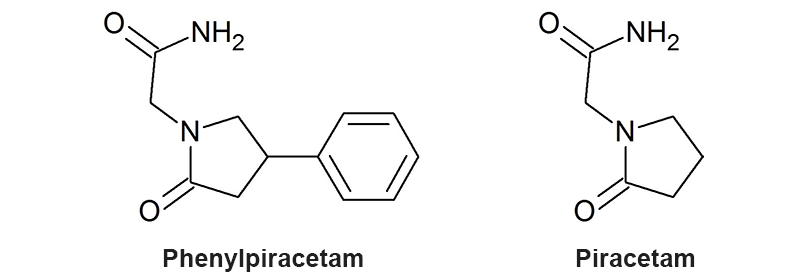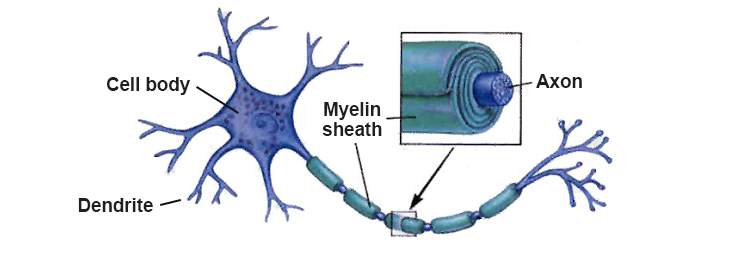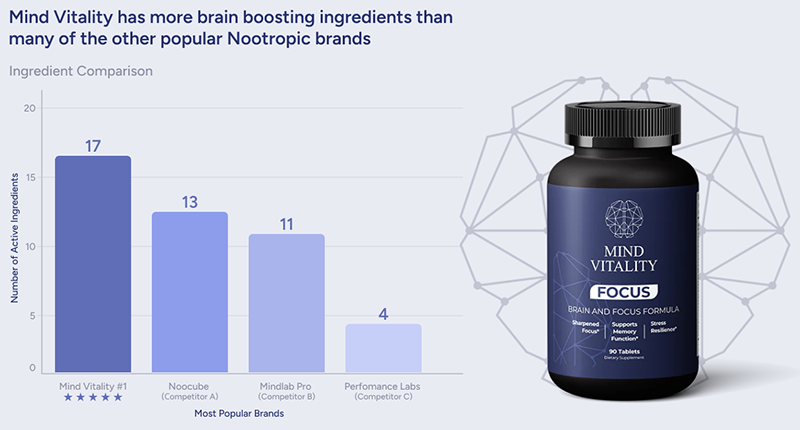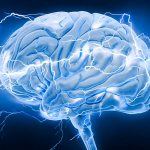Racetams are a family of synthetic nootropics. The first, and most popular, racetam is piracetam. Recently, though, phenylpiracetam — a racetam derived from piracetam — is gaining consideration as the new leader of racetams.
Phenylpiracetam has been shown to boost memory, learning, focus, clarity, and alertness, and reduce the symptoms of anxiety and depression. Unlike most racetams, phenylpiracetam gives the user a stimulant effect — without the nervous, jittery experience attributed to most drugs or supplements that are considered stimulants.
Contents
What Are Racetams?
Nootropics are substances — whether natural or synthetic compounds, or prescription drugs — that are capable of enhancing cognitive functions. Nootropics can improve learning, memory, and overall brain function. Racetams are a wide category, or family, of synthetic chemicals that act as nootropics.
The first racetam (pronounced rass-uh-tam) was synthesized in 1964 by Dr. Corneliu Giurgea, a Romanian psychologist and chemist. Dr. Giurgea named the first racetam piracetam. Since then numerous other racetams — including the one that is the subject of this post, phenylpiracetam — have been synthesized.
While most of the racetams — including piracetam and phenylpiracetam — are available as supplements, racetam itself isn’t a supplement. That’s because it’s the name of the family of these compounds — it’s not an actual compound itself.
To qualify as a racetam a compound needs to have a specific chemical structure, called a pyrrolidine nucleus. It’s this part of the compound that’s most responsible for any racetam’s cognition-enhancing effects. Racetams are all analogues of the original racetam, piracetam — they are each a compound with a molecular structure very similar to piracetam. The seemingly small structural differences, however, result in vast differences in the effects each imparts on people who take them.
In general, racetams are known most for their effects on the brain — they have the ability to boost characteristics such as memory, learning, focus, mood, and neuroplasticity — the brain’s capability to alter its connections in order to re-wire itself.
Although some racetams provide a powerful boost in both mental and physical energy, they function in a manner much different than stimulants such as Adderall and coffee. The energy from racetams is much smoother, meaning that the user doesn’t experience the jittery or nervous effects that many people experience with traditional stimulants.
What Is Piracetam?
Developed over 50 years ago, piracetam (pronounced pie-rass-uh-tam) can be thought of as the grandfather of racetams. It was the first racetam that was synthesized, and all subsequent racetams that have been developed have a similar molecular structure.
Of the many racetams that have been synthesized, piracetam remains the most popular. That’s because as the first racetam, it’s the most discussed and most researched, and was the first drug that was specifically synthesized for making people smarter. When a person first becomes interested in racetams, piracetam is the one they’ll encounter the most as they study up on this type of nootropic.
Piracetam is good — it’s a potent cognitive enhancer. But just because piracetam serves as the default racetam for beginners doesn’t mean it’s the best racetam for everyone. Other, more recent, racetams pick up where piracetam left off — and some of those have been steadily growing in popularity of late. One of those is phenylpiracetam.
What Is Phenylpiracetam?
Phenylpiracetam (pronounced fen-el-pie-rass-uh-tam) is, like most racetams, a modified version of piracetam — the very first racetam. Phenylpiracetam is sometimes referred to by one of its brand names: Phenotropil or Carphedon.
Phenylpiracetam was synthesized in 1983 by chemists at the Russian Academy of Sciences in 1983. One of their main goals in developing phenylpiracetam was to create a racetam that could be used to reduce stress and boost both the mental and physical performance of astronauts while in space flight. It’s a pretty safe conclusion that the chemists were successful — phenylpiracetam is currently taken by Russian cosmonauts on the International Space Station.
Organic Structure of Phenylpiracetam
Phenylpiracetam is an analogue of piracetam. That means that while there are differences between the two molecules, they are structurally very similar. Phenylpiracetam was developed by adding a phenyl group to piracetam — that’s its only structural difference from piracetam.
Benzene is an organic chemical compound with the molecular formula C6H6. A phenyl group is simply benzene with one atom of hydrogen removed, giving it a molecular formula of C6H5. Though a phenyl group is very similar molecularly to benzene, it’s biological activity is much different. That’s a good thing, as benzene is not something humans want to consume. Phenyl groups on the other hand are very common in the human body. For instance, most proteins in your body contain the amino acid phenylalanine, which has a phenyl group in its structure.

How Phenylpiracetam Works
Phenylpiracetam works much like piracetam, but phenylpiracetam is much more potent. Phenylpiracetam owes its extreme potency to its phenyl group, which gives phenylpiracetam the ability to dissolve in lipids, oils, and fats. This greatly enhances phenylpiracetam’s absorption in the body, and allows it to cross the blood-brain barrier more efficiently and readily. The blood-brain barrier is a protective layer of cells that provides control over substances that are allowed to enter or leave the brain.
The bioavailability of a substance is the proportion which enters circulation and is able to have an active effect. Piracetam provides very good cognitive improvements, but it has a very low bioavailability — it is poorly absorbed by the body. Phenylpiracetam, on the other hand, is superior in that its bioavailability is essentially 100% — there’s almost no waste and the racetam’s effects are maximized.
Phenylpiracetam’s high bioavailability means very low doses of this racetram are enough for this racetam to “do its thing.” But what, exactly, is phenylpiracetam doing? How phenylpiracetam works has a lot to do with its effect on cell receptors.
For cells to be able to react to changes in their environment, they need to be able to receive and process outside signals. These cell signals are typically chemical in nature. In humans, neurotransmitters, hormones, and growth factors are the most common types of chemical signals that affect cells.
The outer wall of a cell has receptors — special proteins that the signaling molecules bind to. Once a signaling molecule binds to a receptor it initiates a physiological response. Any type of signaling molecule can’t bind to any type of receptor — there are different types of receptors, each specific to one type of signaling molecule. For instance, insulin binds to insulin receptors, dopamine binds to dopamine receptors, and so forth.
Here’s how phenylpiracetam works its magic. Phenylpiracetam increases the density of several types of cell receptors. That is, it actually adds more receptors to individual cells. More receptors on a cell means that cell is ready and willing to accept more of the signaling molecules that match the type of the new, additional receptors.
The types of receptors that phenylpiracetam increases is quite impressive: acetylcholine, glutamate, dopamine, GABA, and a few others. Each of these neurotransmitters play important roles in brain health.
- Acetylcholine: Strongly involved in attention, learning, memory, arousal, motivation, and promoting REM sleep.
- Glutamate: Associated with brain excitation, alertness, memory, and learning.
- Dopamine: Promotes pleasure, motivation, attention, reward, memory, regulation of emotions and body movements.
- GABA: Helps with feelings of stress, anxiety, and fear, which produces relaxation. Also increases levels of the feel good hormone serotonin.
Phenylpiracetam Nootropic Benefits
Like piracetam, the racetam it’s derived from, phenylpiracetam enhances memory, focus, mood, learning and other cognitive functions. It’s much more bioavailable than piracetam, and does a better job than piracetam of crossing the blood-brain barrier. The result is that phenylpiracetam has been found to be 30 to 60 times more potent than piracetam. In the battle of piracetam vs phenylpiracetam, the clear winner seems to be phenylpiracetam.
The cognitive effects of phenylpiracetam are numerous — the most commonly experienced benefits are listed here.
Phenylpiracetam Enhances Memory
Phenylpiracetam increases the density of cell receptors that interact with several types of neurotransmitters, including acetylcholine, glutamate, dopamine — all of which play a role in memory formation and recall.
In addition to increasing the number of acetylcholine cell receptors, according to studies phenylpiracetam also increases the amount of acetylcholine released by the hippocampus.
Acetylcholine plays a large role in the function of memory, so this combination of more acetylcholine in the system and more acetylcholine receptors on cells is most likely largely responsible for phenylpiracetam’s ability to enhance memory.
Phenylpiracetam Reduces Anxiety
Phenylpiracetam’s popularity is mostly based on it being a powerful nootropic that boosts brain function. But for many people phenylpiracetam works to reduce anxiety and even depression. Up to now most of that information has been anecdotal, but lately some research is starting to back that up.
Phenylpiracetam’s anti-anxiety properties include a bonus — this racetam doesn’t come with the strong negative side effects many people who are prescribed anti-anxiety and anti-depressant medications experience. There’s no sedative action or feeling that you’re “out of it.”
Phenylpiracetam reduces anxiety by increasing the number of dopamine and GABA cell receptors. Dopamine and GABA are hormones (as well as neurotransmitters) that play a role in mood. Dopamine is considered one of the feel good hormones. Serotonin is another feel good hormone, and GABA increases levels of that hormone.
Phenylpiracetam Is a Neuroprotective
Phenylpiracetam, like all racetams, provides the brain with neuroprotective benefits. Neuroprotection involves the protection of nerve (brain) cells from impairment, damage, or deterioration.
Phenylpiracetam’s neuroprotective powers most likely come from its ability to increase myelin — the protective sheath that surrounds neuron axons.
A neuron passes information to another neuron by sending an electrical signal along its axon where it jumps a small gap to be received by a dendrite on a different neuron. Strong myelin surrounding neuron axons is crucial for proper brain function. Certain medical conditions, such as multiple sclerosis (MS) or stroke, can damage myelin. Phenylpiracetam has the ability to repair and even regrow damaged myelin.

Phenylpiracetam Provides Energy
Nootropics are best known for their cognitive benefits, but some also have physical benefits. Phenylpiracetam is such a nootropic — it is considered a brain enhancer and a psychostimulant. A psychostimulant is a psychotropic substance (something that affects one’s mental state) that has the ability to stimulate the central nervous system. That is, it can cause some degree of excitation, elevation of mood, and increased alertness.
In short, phenylpiracetam is both a nootropic and a stimulant. The stimulant part is what has made phenylpiracetam popular with athletes. This racetam enhances physical performance and endurance, and improves motion and movement, and even increases resistance to cold. Bodybuilders and athletes often use it as a pre-workout supplement to improve their workouts.
For proof that phenylpiracetam has stimulant properties look no further than the World Anti-Doping Agency (WADA) — that organization lists phenylpiracetam as a banned substance of athletic competitions.
The best part of phenylpiracetam’s psychostimulant properties is that they don’t come at the cost of feeling anxious or jittery, as is often the case with prescription stimulants.
Phenylpiracetam Improves Focus and Concentration
Phenylpiracetam gives a person a boost in energy, and that energy increase isn’t just physical. If you’re experiencing tiredness of thought, or fuzziness in thinking, after taking phenylpiracetam that fog will be lifted. And unlike many nootropics, the effects can be within minutes rather than days or weeks. Almost immediately your thoughts become clearer and sharper.
The improvement in focus and concentration from phenylpiracetam has been compared to the effects of the prescription drug Adderall. Many people who have taken both (separately) say the effects of each are almost identical. Here the racetam holds one clear advantage — phenylpiracetam is not addictive. You can stop taking phenylpiracetam at any time without fear of experiencing any withdrawal symptoms. That makes phenylpiracetam almost impossible to abuse.
How to Take Phenylpiracetam
Phenylpiracetam is legal in the United States, Canada and U.K. without a prescription, and is available from multiple sources online (the Pure Nootropics website is one good option).
Most people get great results with a low dose once or twice daily, and experience few or no side effects.
Phenylpiracetam Dosage
If you’ve ever taken the original racetam, piracetam, when it comes to taking phenylpiracetam you’ll need to change your mindset in regards to dosage. That’s because phenylpiracetam is many times more powerful than piracetam.
The standard dose for piracetam is in the range of 1,500 mg to 5,000 mg per day. The phenylpiracetam dosage, on the other hand, is just 100 mg to 600 mg per day — with most people choosing to take 400 mg or less per day.
The amount you’ll settle on will depend on how phenylpiracetam affects you. If you’ve never taken a racetam before, it makes sense to start low — try 100 mg, just once per day. After a few days, if you like the effects, but they aren’t as intense as desired, move to 100 mg two times per day.
When To Take Phenylpiracetam
Phenylpiracetam is usually bought in bottles of capsules that are 100 mg each. If you take just 100 mg per day, then you’ll take only one dose per day. Because phenylpiracetam has a stimulating effect you should avoid taking that dose in the evening, as it may interfere with your sleep cycles.
If you take more than 100 mg per day, split your dosage into two doses per day. Taking one dose in the morning and one dose in the early afternoon works best for most people. Again, avoid taking the last dose in the evening.
The above recommendation assumes you’ll be taking this racetam to improve your cognitive abilities during the day, on a daily basis. If you’re instead a student and are taking it specifically to write a paper or study for an exam, then you might want to take a dose in the evening with the intention of staying up late or “pulling an all nighter.” There’s no harm in that, as long as you’re aware that eventually you’re going to “crash” and need extra sleep. Adderall users will be able to relate to this.
Phenylpiracetam is lipid soluable, meaning it dissolves in fats and oils. This is good because cell membranes are lipoid (relating to or resembling fat), so phenylpiracetam diffuses (passes through) cells rapidly. That’s what gives phenylpiracetam it’s high bioavailability. Being lipid soluable means it’s best absorbed by the body when taken with food — ideally food with a higher fat content. So, for best results take your doses with a meal — with breakfast in the morning, and perhaps with a light snack in the afternoon.
Phenylpiracetam Side Effects
When it comes to phenylpiracetam there’s good news on the side effects front — there are very few side effects. When it comes to the effects of any supplement, everybody’s body is different. Nonetheless, the majority of phenylpiracetam users experience no side effects. The only exception to this is headaches, which can be easily remedied.
One way phenylpiracetam improves cognition is by increasing the number of acetylcholine receptors on cell walls (see the How Phenylpiracetam Works section earlier in this article). The now acetylcholine-hungry cells grab available acetylcholine, which can create a situation where your brain uses up more acetylcholine than normal. A shortage of acetylcholine can lead to headaches. The remedy is to take a choline supplement, as choline helps create more acetylcholine in the brain. Choline supplements are covered just ahead in the Phenylpiracetam Stacking With Choline section.
Phenylpiracetam Stacking
In the world of nutritional supplements, stacking refers to taking two or more supplements to achieve some desired effect. Stacking supplements is common with bodybuilders interested in the best way to gain muscle mass. Stacking is also common with people who are interested in the best way to enhance their cognition.
Phenylpiracetam Stacking With Choline
Phenylpiracetam, and most other racetams, work in part by increasing the activity of the neurotransmitter acetylcholine. Phenylpiracetam increases the number of acetylcholine receptors on cell walls, making these cells act like acetylcholine sponges. That’s a good thing — it leads to improved learning and memory. But the higher demand for acetylcholine can deplete the usual levels of acetylcholine in the brain, which for many people leads to headaches.
The simple solution to avoid racetam-headaches is to take a choline supplement along with your phenylpiracetam supplement. Choline is an acetylcholine precursor — through metabolic reactions acetylcholine is formed from choline.
Choline supplements come in a few different forms. The two forms that are the most bioavailable (used most efficiently by the body) and have the ability to easily cross the blood-brain barrier are Alpha GPC and CDP choline (also called citicoline). Optimal Choline Complex from Pure Nootropics is a good choline supplement choice as it consists of a combination of both these preferred forms of choline.
One other point about choline. In addition to it being important to ensuring your body gets the most from your phenylpiracetam supplements, choline is itself a powerful nootropic. As mentioned, choline — a vitamin-like nutrient — is a precursor to acetylcholine, and it’s also a precursor to phosphatidylcholine, or PC, which is a key component of cellular membranes. A choline supplement on its own is helpful in improving memory and learning, so taking it with a phenylpiracetam supplement makes for a powerful nootropic stack.
Phenylpiracetam Stacking With Other Racetams
Racetams are all nootropics, but the many different racetams each have different effects on cognition. One may be best known for improving focus, another may have a reputation for lessening anxiety, and still another may primarily affect long-term memories.
Aside from taking choline along with phenylpiracetam, it’s not necessary to add additional racetams to your stack. But when has necessity ever been important to people who love exploring the world of nootropics! People who try racetams usually end up loving racetams — and they want to try more, and experiment with more. If you end up matching this description, you’ll want to consider adding one, two, or even three more racetams to your daily supplement regimen. Combining racetams can provide a synergistic effect, with each further boosting the benefits of the others.
Conclusion
Racetams are considered to be some of the first true nootropics, and are very effective for enhancing a variety of cognitive abilities including learning, memory, focus, and mood.
Piracetam, synthesized in 1964, is the first racetam. Phenylpiracetam is a slight modification to piracetam, resulting in a big difference in potency. Phenylpiracetam also has greater positive effects on learning capacity, memory, and mood. If the choice is between piracetam or phenylpiracetam, most people opt for phenylpiracetam.
Unlike piracetam — and most other racetams — phenylpiracetam has a stimulant effect that contributes to its ability to provide users with resistance to mental and physical fatigue.
Phenylpiracetam works much faster than other racetams. It’s non-addictive, and even though it’s a stimulant users experience no jittery or nervous feelings.
With its benefits to memory, mood, concentration, mental clarity, focus, and alertness, along with its stimulating effects, phenylpiracetam is considered by many to be the most powerful of the racetams.






